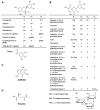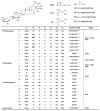Occurrence of Functional Molecules in the Flowers of Tea (Camellia sinensis) Plants: Evidence for a Second Resource
- PMID: 29596355
- PMCID: PMC6017242
- DOI: 10.3390/molecules23040790
Occurrence of Functional Molecules in the Flowers of Tea (Camellia sinensis) Plants: Evidence for a Second Resource
Abstract
Tea (Camellia sinensis) is an important crop, and its leaves are used to make the most widely consumed beverage, aside from water. People have been using leaves from tea plants to make teas for a long time. However, less attention has been paid to the flowers of tea plants, which is a waste of an abundant resource. In the past 15 years, researchers have attempted to discover, identify, and evaluate functional molecules from tea flowers, and have made insightful and useful discoveries. Here, we summarize the recent investigations into these functional molecules in tea flowers, including functional molecules similar to those in tea leaves, as well as the preponderant functional molecules in tea flowers. Tea flowers contain representative metabolites similar to those of tea leaves, such as catechins, flavonols, caffeine, and amino acids. The preponderant functional molecules in tea flowers include saponins, polysaccharides, aromatic compounds, spermidine derivatives, and functional proteins. We also review the safety and biological functions of tea flowers. Tea flower extracts are proposed to be of no toxicological concern based on evidence from the evaluation of mutagenicity, and acute and subchronic toxicity in rats. The presence of many functional metabolites in tea flowers indicates that tea flowers possess diverse biological functions, which are mostly related to catechins, polysaccharides, and saponins. Finally, we discuss the potential for, and challenges facing, future applications of tea flowers as a second resource from tea plants.
Keywords: Camellia sinensis; amino acid; aroma; polysaccharide; saponin; tea flower.
Conflict of interest statement
The authors declare no conflict of interest.
Figures




References
-
- Wan X.C. Tea Biochemistry. 3rd ed. China Agriculture Press; Beijing, China: 2003. pp. 8–67. (In Chinese)
Publication types
MeSH terms
Substances
LinkOut - more resources
Full Text Sources
Other Literature Sources
Medical
Miscellaneous

